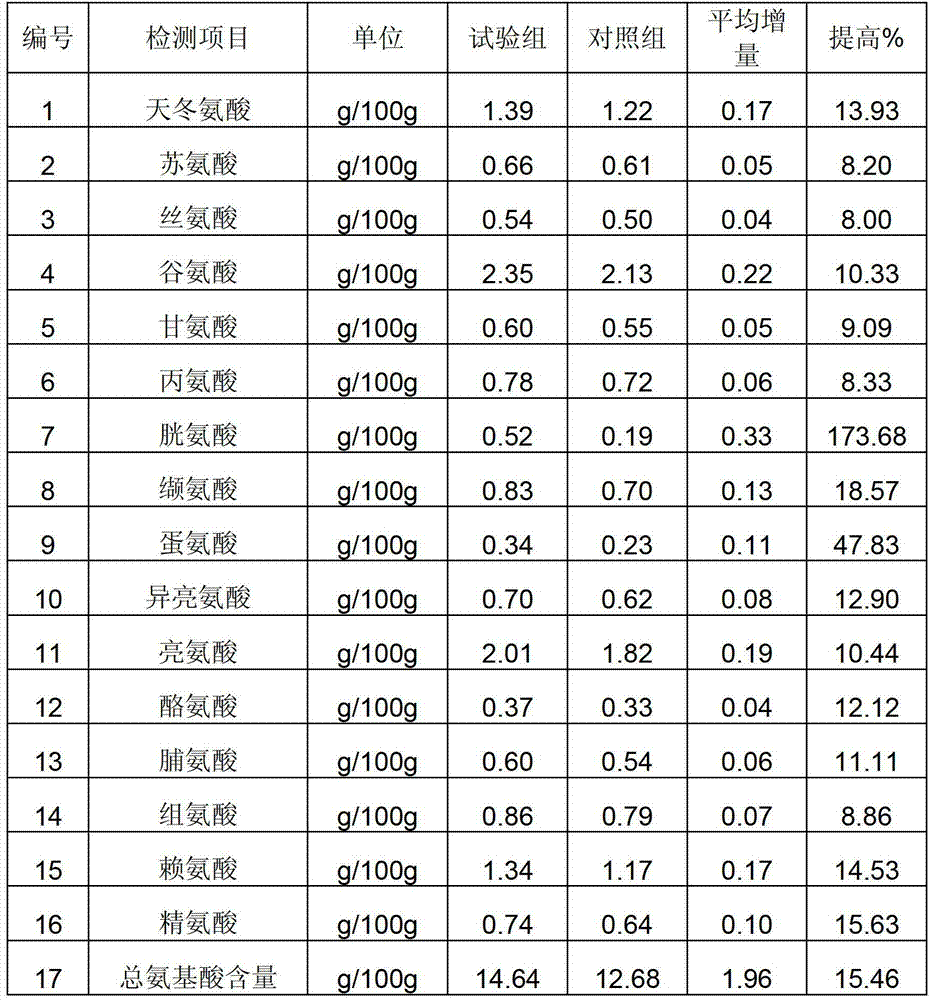Method for preparing microbial fermented feed for effectively improving mutton quality
A technology for microbial fermentation and mutton, applied in the field of microbial fermentation feed production, can solve the problems of not fundamentally improving meat quality, weakening animal meat quality, reducing growth-promoting antibiotics, etc., to improve feed utilization, increase feed intake, The effect of reducing the ratio of feed to meat
- Summary
- Abstract
- Description
- Claims
- Application Information
AI Technical Summary
Problems solved by technology
Method used
Image
Examples
Embodiment 1
[0043] Step 1: Prepare the culture medium
[0044] Dissolve 1.5wt% beef extract, 1wt% peptone, 0.01wt% potassium dihydrogen phosphate, 0.03wt% magnesium sulfate, and 0.75wt% vitamin B family with warm water to form a compound medium with a pH value of 6.5.
[0045] The second step: prepare the compound bacterial liquid
[0046] Inoculate the composite bacterial species into the compound medium made in the first step according to the weight ratio of 7:100. The composite bacterial species has 5 parts by weight of yeast, 10 parts by weight of Bacillus licheniformis, 40 parts by weight of lactic acid bacteria, and 15 parts by weight of Bacillus subtilis. Composition in parts by weight, cultivated at a temperature of 30°C for 100 hours to obtain a composite bacterial liquid.
[0047] The third step: making the finished product of microbial fermented feed
[0048]3 parts by weight of the bacterial liquid cultivated in the second step, 30 parts by weight of corn flour, 3 parts by w...
Embodiment 2
[0050] Step 1: Prepare the culture medium
[0051] Dissolve 1.7wt% beef extract, 1.2wt% peptone, 0.02wt% potassium dihydrogen phosphate, 0.04wt% magnesium sulfate, and 1wt% vitamin B family with warm water to form a compound medium with a pH value of 6.5.
[0052] The second step: prepare the compound bacterial liquid
[0053] Inoculate the composite bacterial species into the compound medium made in the first step according to the weight ratio of 10:100. The composite bacterial species has 7 parts by weight of yeast, 14 parts by weight of Bacillus licheniformis, 42 parts by weight of lactic acid bacteria, and 18 parts by weight of Bacillus subtilis. Composition in parts by weight, cultivated at a temperature of 32°C for 100 hours to obtain a composite bacterial liquid.
[0054] The third step: making the finished product of microbial fermented feed
[0055] 4 parts by weight of the bacterial liquid cultivated in the second step, 40 parts by weight of corn flour, 4 parts by ...
Embodiment 3
[0057] Step 1: Prepare the culture medium
[0058] Dissolve 1.8wt% beef extract, 1.35wt% peptone, 0.03wt% potassium dihydrogen phosphate, 0.05wt% magnesium sulfate, and 1.2wt% vitamin B family with warm water to form a compound medium with a pH value of 6.5.
[0059] The second step: prepare the compound bacterial liquid
[0060] Inoculate the composite bacterial species into the compound medium made in the first step according to the weight ratio of 12:100. The composite bacterial species has 9 parts by weight of yeast, 18 parts by weight of Bacillus licheniformis, 46 parts by weight of lactic acid bacteria, and 22 parts by weight of Bacillus subtilis. Composition in parts by weight, cultivated at a temperature of 35°C for 100 hours to obtain a composite bacterial liquid.
[0061] The third step: making the finished product of microbial fermented feed
[0062] 4.5 parts by weight of the bacterium liquid cultivated in the second step, 42 parts by weight of corn flour, 4.5 pa...
PUM
 Login to View More
Login to View More Abstract
Description
Claims
Application Information
 Login to View More
Login to View More - R&D Engineer
- R&D Manager
- IP Professional
- Industry Leading Data Capabilities
- Powerful AI technology
- Patent DNA Extraction
Browse by: Latest US Patents, China's latest patents, Technical Efficacy Thesaurus, Application Domain, Technology Topic, Popular Technical Reports.
© 2024 PatSnap. All rights reserved.Legal|Privacy policy|Modern Slavery Act Transparency Statement|Sitemap|About US| Contact US: help@patsnap.com








